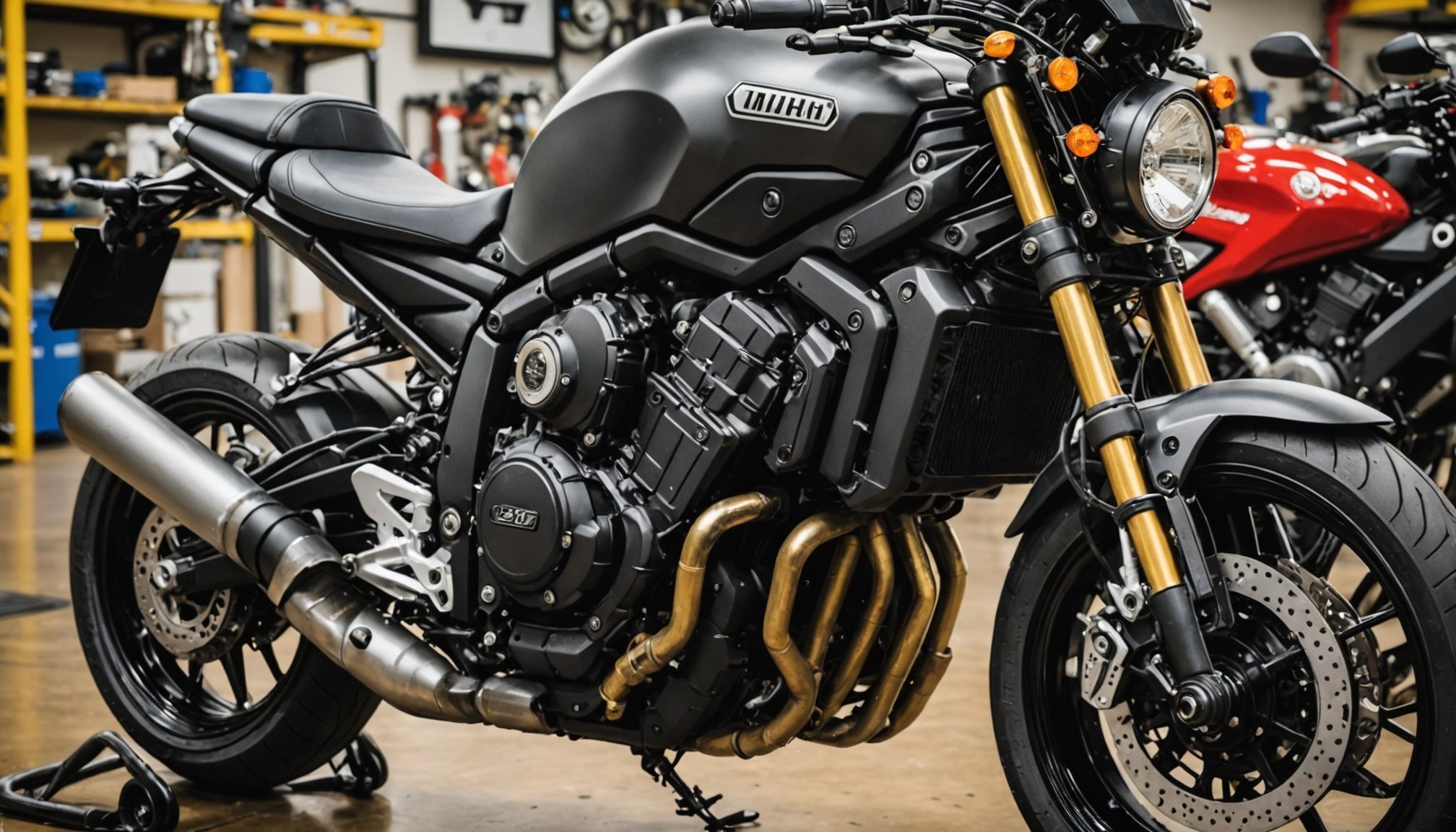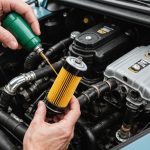Ultimate DIY Guide: Replacing Spark Plugs on Your Yamaha XSR700 Made Easy
Why Replace Spark Plugs?
Replacing the spark plugs on your Yamaha XSR700 is a crucial maintenance task that can significantly impact your bike’s performance, fuel efficiency, and overall health. Over time, spark plugs can become worn out, leading to issues like misfires, reduced power, and decreased fuel efficiency.
“As spark plugs age, they can start to misfire, which not only affects the performance of your bike but also increases fuel consumption,” explains a seasoned mechanic. “Replacing them regularly ensures your Yamaha XSR700 runs smoothly and efficiently.”
Topic to read : Unlocking cylinder head torque: the ultimate guide for your royal enfield bullet 500 enthusiast
Preparing for the Job
Before you start, make sure you have all the necessary tools and parts. Here’s a detailed list of what you’ll need:
Tools and Parts
- Spark plug socket: A spark plug socket is essential for removing and installing the spark plugs. Ensure it fits your Yamaha XSR700’s spark plug size.
- Ratchet and extension: These will help you reach the spark plugs, especially if they are located in hard-to-reach areas.
- Torque wrench: To ensure the spark plugs are tightened to the correct specification.
- New spark plugs: Choose the correct type and number of spark plugs for your Yamaha XSR700. For example, the NGK MR7E-9 is a common choice for many bikes, including some Yamaha models[2].
- Gloves and safety glasses: For protection while working on your bike.
- XSR manual: Refer to your Yamaha XSR700 manual for specific instructions and torque specifications.
Step-by-Step Guide to Spark Plug Removal
Removing the spark plugs is a relatively straightforward process, but it requires some care to avoid damaging the engine or the spark plug threads.
In the same genre : Ultimate guide to replacing and adjusting the throttle cable on your yamaha v-max: expert tips and techniques
Locating the Spark Plugs
The spark plugs on your Yamaha XSR700 are typically located on the side of the engine or near the cylinder head. Consult your XSR manual to find the exact location.
Removing the Spark Plug Caps
Start by removing the spark plug caps. These caps protect the spark plug wires and need to be pulled off gently to avoid damaging the wires.
Using the Spark Plug Socket
Insert the spark plug socket into the ratchet and attach the extension if necessary. Place the socket over the spark plug and turn it counterclockwise until the plug is loose. Then, carefully pull the spark plug out.
### Tips for Spark Plug Removal
- Use a spark plug socket with a rubber insert to prevent damaging the spark plug.
- If the spark plug is stuck, do not force it. Instead, use a spark plug removal tool or consult a professional.
- Take note of the spark plug wire orientation to ensure correct reinstallation.
Inspecting and Cleaning the Spark Plug Wells
Before installing new spark plugs, inspect and clean the spark plug wells to ensure they are free from debris.
Inspecting the Wells
Use a flashlight and a spark plug well cleaner to inspect the wells. Look for any signs of oil or debris that could interfere with the new spark plug.
Cleaning the Wells
If you find any debris, use compressed air or a spark plug well cleaner to clean out the wells. This step is crucial to ensure the new spark plugs function correctly.
Installing the New Spark Plugs
Installing the new spark plugs is the reverse of the removal process, but with a few key considerations.
Inserting the New Spark Plug
Place the new spark plug into the spark plug well and turn it clockwise by hand until it is snug. Then, use your torque wrench to tighten the spark plug to the specified torque.
Reinstalling the Spark Plug Caps
Once the spark plug is installed, put the spark plug cap back on. Ensure it is securely attached to prevent any misfires.
### Torque Specifications
- Refer to your Yamaha XSR700 manual for the correct torque specification. Typically, it is around 10-15 ft-lbs.
- Use a torque wrench to avoid over-tightening, which can damage the engine threads.
Testing Your Bike
After replacing the spark plugs, it’s essential to test your bike to ensure everything is working correctly.
Starting the Engine
Start the engine and listen for any unusual sounds or vibrations. If the bike starts smoothly and runs without any misfires, you have successfully replaced the spark plugs.
Taking a Test Ride
Take your Yamaha XSR700 for a test ride to feel the difference. A good set of spark plugs should improve the engine’s performance, making it feel more responsive and powerful.
Common Issues and Troubleshooting
Sometimes, even after replacing the spark plugs, you might encounter issues. Here are some common problems and how to troubleshoot them:
Misfires
If your bike is still misfiring after replacing the spark plugs, check the spark plug wires for any signs of wear or damage. Ensure the spark plug caps are securely attached.
Poor Performance
If your bike is not performing well after the replacement, check the air filter and fuel filter. A dirty air filter or clogged fuel filter can reduce engine performance.
Replacing the spark plugs on your Yamaha XSR700 is a relatively simple DIY task that can significantly improve your bike’s performance and fuel efficiency. By following the steps outlined above and using the right tools and parts, you can ensure your bike runs smoothly and efficiently.
“Replacing spark plugs is one of those maintenance tasks that really makes a difference in how your bike rides,” says a Yamaha enthusiast. “It’s like giving your bike a new lease on life.”
Additional Tips and Considerations
Here are some additional tips to keep in mind when working on your Yamaha XSR700:
Build Quality and Durability
When choosing spark plugs, consider the build quality and durability. High-quality spark plugs like those from NGK are designed to last longer and provide better performance.
Universal Joint and Socket Compatibility
Ensure the spark plug socket and universal joint are compatible with your Yamaha XSR700. Using the wrong tools can damage the engine or the spark plug threads.
Riding Tips
Regularly replacing spark plugs is part of good bike maintenance. Here are some riding tips to keep your Yamaha XSR700 in great condition:
- Regular Maintenance: Regularly check and maintain your bike’s air filter, fuel filter, and oil to ensure optimal performance.
- Safe Riding: Always wear protective gear and follow safe riding practices to avoid accidents.
- Storage: Store your bike in a dry, clean area to protect it from the elements.
By following these tips and the step-by-step guide above, you can keep your Yamaha XSR700 running like new and enjoy a great ride every time.
Comparative Table: Spark Plug Options for Yamaha XSR700
Here is a comparative table of some popular spark plug options for your Yamaha XSR700:
| Spark Plug Model | Manufacturer | Price (Incl. VAT) | Features |
|---|---|---|---|
| NGK MR7E-9 | NGK | €6.22 | High-quality, long-lasting, compatible with many Yamaha models[2] |
| BOSCH Platinum+4 | Bosch | €8.50 | Four yttrium-enhanced ground electrodes for improved durability |
| DENSO Iridium | Denso | €10.00 | Iridium tip for longer life and better performance |
| BRISK Silver | Brisk | €7.00 | Silver center electrode for better conductivity |
Quotes from Experts and Enthusiasts
Here are some quotes from experts and enthusiasts that highlight the importance of spark plug maintenance:
- “Spark plugs are the heart of your engine. Keeping them in good condition ensures your bike runs smoothly and efficiently,” says a motorcycle mechanic.
- “I replaced my spark plugs recently, and it was like riding a new bike. The performance improvement was noticeable right away,” comments a Yamaha XSR700 owner.
- “Regular spark plug replacement is key to maintaining your bike’s performance and extending its lifespan,” advises a motorcycle maintenance expert.
By following this guide and keeping your spark plugs in good condition, you can enjoy a great ride on your Yamaha XSR700 every time you hit the road.











